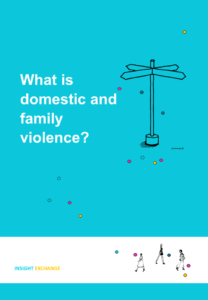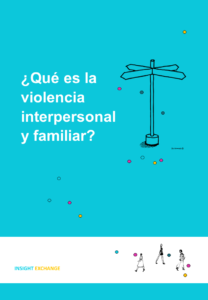What is domestic and family violence?
View the short Insight Exchange animation ‘What is DFV?’ (4mins)
Read more in the adjacent PDFs provided in English and Spanish.
What is domestic and family violence? PDF (English)
¿Qué es la violencia interpersonal y familiar? PDF (Español)
National, state and territory definitions of domestic and family violence and criminal codes vary, however violence and abuse is never acceptable in any community, family, institution, place or context.
Domestic and family violence refers to behaviour that occurs in: a current or former intimate partner relationship, a domestic or family relationship, or in an extended family or kinship group.
It can be perpetrated by a partner, spouse, family member, carer, house mate, boyfriend or girlfriend.
Domestic and family violence is behaviour in one of these relationships which is threatening, abusive, violent, coercive or controlling; causing a person to live in fear and to be made to do things against their will.
Domestic, family and sexualised violence can happen to anyone. It is in every postcode and community and can take many forms.
Some of the behaviours that may represent domestic and family violence include…
Emotional or psychological abuse such as verbal abuse, threats of violence, isolation, and undermining the victim’s sense of reality.
More examples:
- verbal abuse
- humiliation
- degradation
- threats of violence
- threats of self-harm or suicide,
- blackmail and bribery
- manipulative use of children to control partner or family members
- isolating the victim from family and friends
- threatening to ‘out’ a partner’s identity as LGBTIQ or HIV without consent
- Gaslighting
Physical violence such as physical assault, non-fatal strangulation, and damage or harm to person, pets and property.
More examples:
- hitting
- slapping
- pushing
- punching
- kicking
- choking
- suffocating
- strangling
- other forms of harm or injury
- hurting pets
- damaging items and property
Sexualised violence such as sexualised assault and other abusive or coercive behaviour of a sexualised nature.
More examples:
- Forced genital contact
- Rape
- Unwanted touching
- Voyeurism
- Forcing the victim to watch or be involved in pornography
- Forced or concealed use of intoxicants to minimise resistance
- Other coercive behaviour of a sexualised nature
Reproductive coercion or abuse. When a person is stopped from making their own choices about reproduction.
More examples:
- Contraception sabotage
- Pressuring another person into pregnancy.
- Forcing another person to continue a pregnancy
- Forcing another person to terminate a pregnancy.
- Forcing or coercing a person into sterilisation
Economic abuse such as denying a person reasonable financial autonomy or financial support - or accruing debt in their name.
More examples:
- controlling access to cash and bank accounts
- hiding financial information and assets
- sabotaging study and/or employment opportunities
- forcing a partner to take out debt
- manipulating finances to avoid or reduce child support payments
Stalking and intimidation such as surveillance and harassment.
More examples:
- Surveillance
- Harassment
- Attempts to control a person’s movements
- Intimidation of a person or their family
Technology facilitated abuse whereby a perpetrator uses electronic devices and online services to monitor, control, threaten, harass or abuse a person.
More examples:
- online harassment
- repeated calls or texts
- virtual stalking
- impersonation
- threats through mobile devices
- attacks on social media
- threats made using online accounts
- image based abuse
Spiritual or religious abuse in which spiritual or religious beliefs are used to scare, hurt or control a person.
More examples:
- Stopping or shaming a person for practising their spiritual or religious beliefs
- forcing someone to take part in spiritual or religious practices when they don't want to
- using religious or spiritual leaders or teachings to force someone to stay in a relationship or as an excuse for violent and abusive behaviour.
Systems abuse is closely related to economic abuse. It involves using services and systems to harm and control victims.
More examples:
- Delaying court proceedings
- Hiding information from authorities
- Vexatious allegations and complaints
- Manipulating taxes, evidence and records
- Weaponing processes to maximise costs
Perpetrators of violence often use services and systems as part of their violence during and after a relationship has ended – causing ongoing financial hardship.
Domestic and family violence is often a pattern of controlling or coercive behaviour.
But whenever people are subjected to abuse, coercive control, and violence, they resist.
Resistance is any act that:
- opposes the violence and abuse
- attempts to limit its affects
- attempts to uphold dignity and/or build on safety for one’s self or others
Resistance to violence can be verbal, physical, mental, emotional, spiritual, financial, practical and more.
Perpetrators of violence and abuse anticipate and work to suppress and overpower victims’ resistance.
Because of this, acts of resistance must often be hidden.
But whether resistance to violence is hidden or visible – it is always there.
People resist violence and abuse overtly and covertly in creative, resourceful and clever ways; sometimes in seemingly illogical and harmful ways; sometimes in careful and cautious ways, but always to uphold or reclaim their dignity and often to stay safe and protect the people they love.
By understanding a victim’s resistance to violence, we better identify the deliberateness and intensity of the violence used against them.
We see that just because they couldn’t stop the violence, doesn’t mean they ‘let it happen’.
Coates, L., & Wade, A. (2007). Language and Violence; Analysis of Four Discursive Operations. Journal of Family Violence, 22 (7), 511-522.
Wade, A. (1997). Small acts of living: Everyday resistance to violence and other forms of oppression. Journal of Contemporary Family Therapy, Vol 19, pp. 23–40.
Wade, A. (2000). Resistance to interpersonal violence: Implications for the practice of therapy. Unpublished doctoral dissertation, University of Victoria, Victoria, BC.
An intimate relationship refers to people who are (or have been) in an intimate partnership whether or not the relationship involves or has involved a sexual relationship, i.e. married or engaged to be married, separated, divorced, de facto partners (whether of the same or different sex), couples promised to each other under cultural or religious tradition, or who are dating.
A family relationship has a broader definition and includes people who are related to one another through blood, marriage or de facto partnerships, adoption and fostering relationships, sibling and extended family relationships. It includes Kinship connections in Aboriginal and Torres Strait Islander communities (see – Family Violence), extended family relationships, and family of choice within Lesbian, Gay, Bisexual, Transgender, Intersex, Queer and Asexual + (LGBTIQA+) families and communities.
People living in the same house, people living in the same residential or institutional facility and people reliant on care may also be considered to be experiencing DFV when one or both people in the relationship try to create an imbalance of power to establish coercive control and commit violence.
Women and children are overwhelmingly the victims of dfv and those who use violence are overwhelmingly male.
DFV can be perpetrated by a partner, family member, carer, house mate, boyfriend or girlfriend. Women also commit DFV against men, as do same-sex partners (DVNSW, 2018). DFV is also committed by and committed against people who identify as transgender, non-binary, intersex and gender-diverse.
What is Family Violence?
First Nations people’s have advocated for the term ‘family violence’ to be used in conjunction with ‘domestic violence’ in recognition of the violence and abuse that can be used within partnerships, families, extended families, Kinship networks and communities. “Focusing on the term ‘domestic violence’ will not lead to full consideration of, and response to, the destructive effects of colonisation on Indigenous culture and social systems. The intersection of race, gender, age and power, and the disruption of the relationship between spiritual, cultural and environmental dimensions, must be considered in order to understand violence in Indigenous communities” (The Aboriginal and Torres Strait Islander Women’s Task Force on Violence, 2000, p.115).
The term ‘family violence’ describes physical, emotional, sexual, social, spiritual, cultural, psychological and economic abuses that may be perpetrated within a family and community. The term also recognises the broader impacts of colonial violence and racism on First Nations families, intergenerationally, through extended families and Kinship connections and community relationships. It has also been used in the past decade to include lateral violence, self-harm and suicide, and has become widely adopted as part of the shift towards addressing familial violence in all its forms. (Gordon, 2002).


